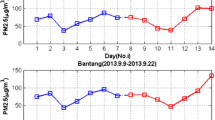Abstract
Instant Messaging (IM) has been an effective, popular and important mode for immediate communication in the digital age. Then analysis of daily user-online movement in IM is increasingly important for its significant effect on information propagation, commercial operation, resource allocation and maintenance management. In this study, the so-called elliptic orbit model is proposed to describe daily user-online movement in IM by mapping its time-series into the polar coordinates to establish the elliptic orbit model, in which each 24-hour movement is depicted as one elliptic orbit. Experiments in the most popular IM service in China called the Tencent QQ and result analysis indicate potentiality of the proposed method. It is shown that the daily 24-hour user-online movement in IM is well described by the elliptic orbit model, which provides a vivid approach for modeling and predicting daily user-online movement in IM in a concise and intuitive way.






























Similar content being viewed by others
References
Neviarouskaya A, Prendinger H, Ishizuka M (2010) User study on affect IM, an avatar-based instant messaging system employing rule-based affect sensing from text. Int J Human-Comput Stud 68(7):432–450
Yasin M, Qureshi JA, Kausar F, Kim JS, Seo J (2014) A granular approach for user-centric network analysis to identify digital evidence. Peer-to-Peer Network Appl. doi:10.1007/s12083-014-0250-x
To P-L, Liao CC, Chiang JC, Shih M-L, Chang C-Y (2008) An empirical investigation of the factors affecting the adoption of instant messaging in organizations. Comput Standards Interf 30(3):148–156
Bardi CA, Brady MF (2010) Why shy people use instant messaging: loneliness and other motives. Comput Hum Behav 26(6):1722–1726
Birnholtz J (2010) Adopt, adapt, abandon: Understanding why some young adults start, and then stop, using instant messaging. Comput Hum Behav 26(6):1427–1433
Ou CXJ, Davison RM (2011) Interactive or interruptive? instant messaging at work. Decis Support Syst 52(1):61–72
Lin CP (2011) Assessing the mediating role of online social capital between social support and instant messaging usage. Electron Commer Res Appl 10(1):105–114
Zaman M, Anandarajan M, Dai QZ (2010) Experiencing flow with instant messaging and its facilitating role on creative behaviors. Comput Hum Behav 26(5):1009–1018
Goh OS, Fung CC, Depickere A (2008) Domain knowledge query conversation bots in instant messaging (IM). Knowl-Based Syst 21(7):681–691
Christy S, Cheung MK, Lee MKO, Chen HP (2011) How social influence affects we-intention to use instant messaging: the moderating effect of usage experience. Inf Syst Front 13(2):157–169
Xie MJ, Wu ZY, Wang HN (2012) Secure instant messaging in enterprise-like networks. Comput Netw 56(1):448–461
Bønes E, Hasvold P, Henriksen E, Strandenæs T (2007) Risk analysis of information security in a mobile instant messaging and presence system for healthcare. Int J Med Inform 76(9):677–687
StatSoft, Inc (2013) Electronic statistics textbook. Tulsa, OK: StatSoft. WEB: http://www.statsoft.com/textbook/ Accessed 1 March 2013
Chatfield C (2004) The analysis of time series. Chapman & Hall/CRC, New York
Chatterjee S, Hadi A, Price B (2000) Simple linear regression. in regression analysis by example, 3rd edn. Wiley, New York, pp 21–50
Yang Z-C (2007) A study on the orbit of air temperature movement. Environ Model Assess 12(2):131–143
Yang Z-C (2012) Electric load evaluation and forecast based on the elliptic orbit algorithmic model. Int J Electric Power Energy Syst 42(1):560–567
Yang Z-C (2014) Modeling and forecasting monthly passenger load movement based on the elliptic orbit algorithmic model. J Comput Civ Eng. doi:10.1061/(ASCE)CP.1943-5487.0000383, In Press
Acknowledgments
The research was supported by Scientific Research Fund of Hunan Provincial Science and Technology Department (2013GK3090) and Research Fund of Hunan University of Science and Technology (E50811). The author would like to extend his thanks the editor(s) and anonymous reviewer(s) for their suggestions in improving the paper.
Author information
Authors and Affiliations
Corresponding author
Rights and permissions
About this article
Cite this article
Zong-chang, Y. Modeling and forecasting of daily online-user movement in instant messaging based on the elliptic-orbit model: A case study for China. Peer-to-Peer Netw. Appl. 9, 284–298 (2016). https://doi.org/10.1007/s12083-015-0336-0
Received:
Accepted:
Published:
Issue Date:
DOI: https://doi.org/10.1007/s12083-015-0336-0




